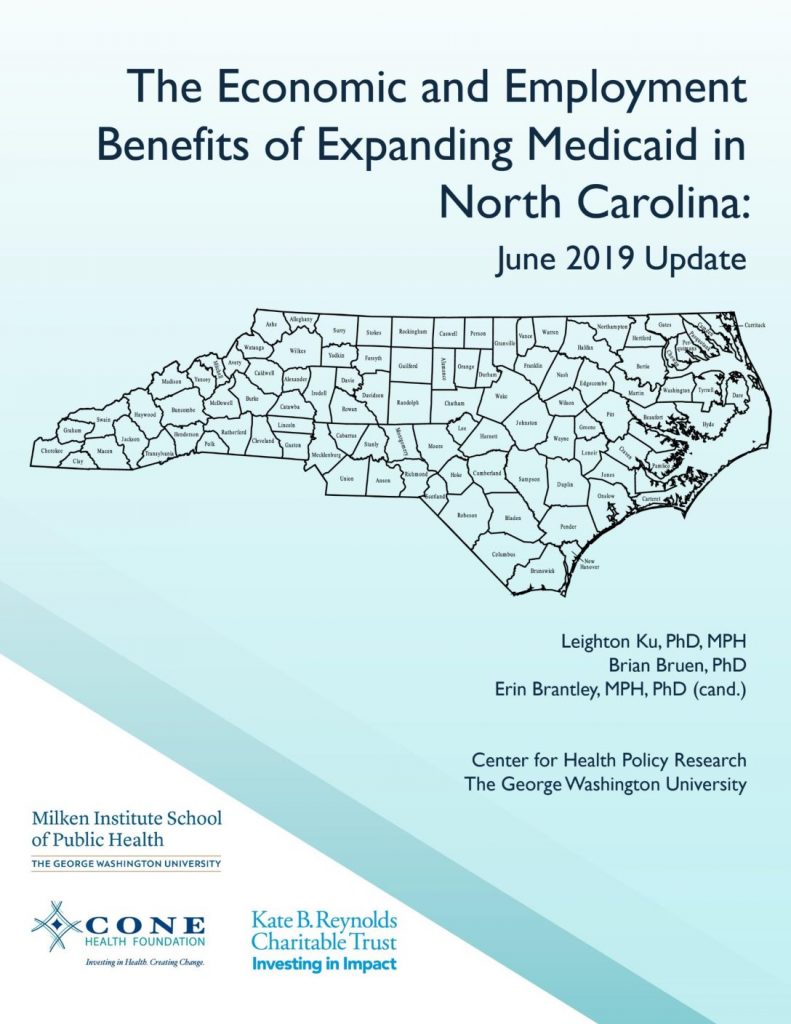From the Executive Summary
Governor Roy Cooper has proposed expanding eligibility in North Carolina’s Medicaid health insurance program. North Carolina currently covers parents with incomes up to 42 percent of the poverty line and generally does not cover adults without dependent children. The expansion would lift income criteria to 138 percent of the poverty line for adults 19 to 64 ($29,400 for a family of three). North Carolina is one of 14 states that has not expanded Medicaid; only eight states in the U.S. have more austere income guidelines.
This brief is an update of a December 2014 report about the potential economic and employment consequences of expanding Medicaid in North Carolina. The earlier report examined the consequences of not expanding Medicaid in 2014 and then estimated what would happen if the Tar Heel state expanded it in 2016. This report addresses the consequences of the Governor’s proposal to expand Medicaid beginning November 2019. It offers a nonpartisan analysis of potential changes in economic growth at the state level and in each of North Carolina’s 100 counties.
Briefly, the analysis indicates that if Medicaid is expanded:
- In Calendar Year 2020, about 464,000 more people will gain Medicaid coverage. This will rise to about 634,000 people in 2022, then stabilize.
- New federal funding flowing into North Carolina will rise by $2.8 billion in 2019 and gradually climb to $4.7 billion by 2022 because the federal government would pay 90 percent of Medicaid costs for newly eligible adults. From 2020 to 2022, North Carolina will gain $11.7 billion more in federal funding.
- The injection of billions of dollars into North Carolina’s economy will spur business activity, which will in turn create more jobs. We estimate that 24,400 additional jobs would be created in 2020, climbing to 37,200 more jobs in 2022, compared to levels if Medicaid is not expanded.
- The Gross State Product (a measure of economic activity in North Carolina) would be increased by $1.9 billion in 2020 and $2.9 billion in 2022.
- The increased economic activity and employment would trigger increases in state and county tax revenues, totaling $500 million in state revenue from 2020 to 2022 and $100 million in county revenue over the three-year period. The additional revenues can help the state and the counties address other budgetary needs.
Since more low-income people will get health insurance coverage, increasing health care access across the state, the benefits will be broadly dispersed. This analysis estimates economic gains in all 100 counties. Almost half the job gains – 17,900 jobs by 2022 — will occur in six large counties (Buncombe, Durham, Forsyth, Guilford, Mecklenburg and Wake Counties), while the other 19,200 new jobs will be distributed across the rest of the state, including rural areas.
Slightly more than half of the job growth (20,600 jobs) would be in the health care field, hardly surprising since Medicaid is a health insurance program. But the other 16,600 jobs created would be in other fields such as construction, retail sales, professional and management services, etc.
Although Medicaid funds would first flow to health care providers, they would then ripple out into other parts of the economy as staff employed in health and other fields purchase food, pay their rent and mortgages, and make other consumer purchases. The economic growth would increase North Carolina’s tax base and ultimately increase both state and county tax revenues.
The current employment estimates are similar to but a little lower than we projected in 2014. The main reason is that the current proposal would not be effective until late 2019, as compared to the 2016 start assumed before. In addition, projected Medicaid expenditures are somewhat lower than estimated before.
These estimates are projections, based on a sophisticated, dynamic economic model produced by Regional Economic Models, Inc. As with any projection, there is uncertainty and other factors may affect the outcomes. The economic methods employed are well-respected and widely used to estimate effects of changing state and local policies for local economies.
An alternative to the Governor’s proposal has been introduced in the House of Representatives, House Bill 655. It also presents a health insurance option for adults with incomes up to 138 percent of the poverty line but adds requirements that low-income beneficiaries pay monthly premiums and comply with work requirements. We are not aware of detailed analyses of that bill and cannot conduct a comparable analysis. This bill would also increase Medicaid participation and federal funding flowing into the state, compared to current law. However, when compared to the expansion proposed by the Governor, the premiums and work requirements would depress participation. Enrolling fewer North Carolinians would yield lower federal revenue and reduced economic and employment gains.
Medicaid expansion could be an important engine for economic growth and job creation across the breadth of North Carolina. More fundamentally, expanding Medicaid coverage will empower 634,000 low-income North Carolinians get Medicaid coverage by 2022 which will help assure they can get affordable care when they are sick and preventive and primary care to help them stay healthy.

